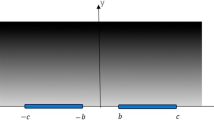Abstract
Mixed-mode crack analysis in unidirectionally and bidirectionally functionally graded materials is performed by using a boundary integral equation method. To make the analysis tractable, the Young's modulus of the functionally graded materials is assumed to be exponentially dependent on spatial variables, while the Poisson's ratio is assumed to be constant. The corresponding boundary value problem is formulated as a set of hypersingular traction boundary integral equations, which are solved numerically by using a Galerkin method. The present method is especially suited for straight cracks in infinite FGMs. Numerical results for the elastostatic stress intensity factors are presented and discussed. Special attention of the analysis is devoted to investigate the effects of the material gradients and the crack orientation on the elastostatic stress intensity factors.
Similar content being viewed by others
References
Abramowitz, M. and Stegun, I.A. (1972). Handbook of Mathematical Functions. Dover Publications, New York.
Anlas, G., Santare, M.H. and Lambros, J. (2000). Numerical calculation of stress intensity factors in functionally graded materials. International Journal of Fracture 104, 131–143.
Chan, Y.-S., Paulino, G.H. and Fannjiang, A.C. (2001). The crack problem for non-homogeneous materials under antiplane shear loading – a displacement based formulation. International Journal of Solids and Structures 38, 2989–3005.
Chan, Y.-S., Gray, L.J., Kaplan, T. and Paulino, G.H. (2004). Green's function for a two-dimensional exponentially-graded elastic medium. Proceedings of the Royal Society of London A 460, 1689–1706.
Chen, J., Wu, L. and Du, S. (2000). Element free Galerkin methods for fracture of functionally graded materials. Key Engineering Materials 183–187, 487–492.
Delale, F. and Erdogan, F. (1983). The crack problem for a nonhomogeneous plane. ASME Journal of Applied Mechanics 50, 609–614.
Dolbow, J.E. and Gosz, M. (2002). On the computation of mixed-mode stress intensity factors in functionally graded materials. International Journal of Solids and Structures 39, 2557–2574.
Eischen, J.W. (1987). Fracture of nonhomogeneous materials. International Journal of Fracture 34, 3–22.
Erdogan, F. and Gupta, G.D. (1972). On the numerical solution of singular integral equations. Quartly Applied Mathematics 29, 525–534.
Erdogan, F. (1978). Mixed boundary-value problem in mechanics. In: Mechanics Today (Ed. by S. Nemat-Nasser), Pergamon Press, 4, 1–86.
Erdogan, F. (1985). The crack problem for bonded nonhomogeneous materials under antiplane shear loading. ASME Journal of Applied Mechanics 52, 823–828.
Erdogan, F. (1995). Fracture mechanics of functionally graded materials. Composites Engineering 5, 753–770.
Gradshteyn, I.S. and Ryzhik, I.M. (1980). Table of Integrals, Series, and Products. Academic Press, Inc., London.
Gu, P. and Asaro, R.J. (1997). Cracks in functionally graded materials. International Journal of Solids and Structures 34, 1–17.
Gu, G. and Asaro, R.J. (1997). Crack deflection in functionally graded materials. International Journal of Solids and Structures 34, 3085–3098.
Gu, G., Dao, M. and Asaro, R.J. (1999). A simplified method for calculating the crack tip field of functionally graded materials using the domain integral. ASME Journal of Applied Mechanics 66, 101–108.
Kim, J.-H. and Paulino, G.H. (2002). Isoparameteric graded finite elements for nonhomogeneous isotropic and orthotropic materials. ASME Journal of Applied Mechanics 69, 502–514.
Kim, J.-H. and Paulino, G.H. (2002). Finite element evaluation of mixed-mode stress intensity factors in functionally graded materials. International Journal for Numerical Methods in Engineering 53, 1903–1935.
Kim, J.-H. and Paulino, G.H. (2003). T-stress, mixed-mode stress intensity factors, and crack initiation angles in functionally graded materials: a unified approach using the interaction integral method. Computer Methods in Applied Mechanics and Engineering 192, 1463–1494.
Konda, N. and Erdogan, F. (1994). The mixed mode crack problem in a nonhomogeneous elastic medium. Engineering Fracture Mechanics 47, 533–545.
Li, H., Lambros, J., Cheeseman, B.A. and Santare, M.H. (2000). Experimental investigation of the quasi-static fracture of functionally graded materials. International Journal of Solids and Structures 37, 3715–3732.
Martin, P.A., Richardson, J.D., Gray, L.J. and Berger, J.R. (2002). On Green's function for a three-dimensional exponentially-graded elastic solid. Proceedings of the Royal Society of London A 458, 1931–1947.
Marur, P.R. and Tippur, H.V. (2000). Numerical analysis of crack-tip fields in functionally graded materials with a crack normal to the elastic gradient. International Journal of Solids and Structures 37, 5353–5370.
Miyamoto, Y., Kaysser, W.A., Rabin, B.H., Kawasaki, A. and Ford, R.G. Ford (eds.) (1999). Functionally Graded Materials. Kluwer Academic Publishers, Boston.
Rao, B.N. and Rahman, S. (2003). Mesh-free analysis of cracks in isotropic functionally graded materials. Engineering Fracture Mechanics 70, 1–27.
Santare, M.H. and Lambros, J. (2000). Use of a graded finite element to model the behavior of nonhomogeneous materials. ASME Journal of Applied Mechanics 67, 819–822.
Sladek, J., Sladek, V. and Zhang, Ch. (2003). Dynamic response of a crack in a functionally graded material under an antiplane shear impact load. Key Engineering Materials 251–252, 123–129.
Sladek, J., Sladek, V. and Zhang, Ch. (2004). An advanced numerical method for computing elastody namic fracture parameters in functionally graded materials. Computational Materials Science, accepted for publication.
Suresh, S. and Mortensen, A. (1998). Fundamentals of Functionally Graded Materials, IOM Communications Ltd., London.
Yue, Z.Q., Xiao, H.T. and Tham, L.G. (2003). Boundary element analysis of crack problems in functionally graded materials. International Journal of Solids and Structures 40, 3273–3291.
Zhang, Ch., Sladek, J. and Sladek, V. (2003). Antiplane crack analysis of a functionally graded material by a BIEM. Computational Materials Science, accepted for publication.
Zhang, Ch., Sladek, J. and Sladek, V. (2003). Numerical analysis of cracked functionally graded materials. Key Engineering Materials 251–252, 463–472.
Zhang, Ch., Sladek, J. and Sladek, V. (2000). Effects of material gradients on transient dynamic mode III SIFs in a FGM. International Journal of Solids and Structures 40, 5251–5270.
Zou, Z.Z., Wu, S.X. and Li, C.Y. (2000). On the multiple isoparametric finite element method and computation of stress intensity factor for cracks in FGMs. Key Engineering Materials 183–187, 511–516.
Author information
Authors and Affiliations
Rights and permissions
About this article
Cite this article
Zhang, C., Sladek, J. & Sladek, V. Crack analysis in unidirectionally and bidirectionally functionally graded materials. International Journal of Fracture 129, 385–406 (2004). https://doi.org/10.1023/B:FRAC.0000049495.13523.94
Issue Date:
DOI: https://doi.org/10.1023/B:FRAC.0000049495.13523.94




